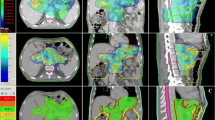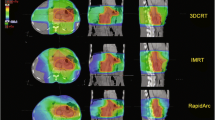Background:
Intensity-modulated radiotherapy (IMRT) allows for improved sparing of organs at risk (OARs) in advanced pancreatic cancer. A planning study evaluated if volumetric modulated arc therapy (RapidArc™ [RA]) could be used as an alternative to IMRT in such cases.
Patients and Methods:
In ten patients, five-field IMRT (5f-IMRT) plans with fixed gantry positions were compared to RA plans using similar constraints for planning target volume (PTV) and OARs. PTV coverage, conformity indices (CI), and OAR doses were compared. One patient was treated using RA and calculated dose distributions were measured in coronal planes in a solid-water phantom.
Results:
RA plans showed superior mean CI of 1.09 ± 0.02 (± 1 SD [standard deviation]) versus 1.20 ± 0.10 in 5f-IMRT (p = 0.003). Both techniques achieved similar sparing of the right kidney, but RA significantly reduced left kidney doses with V15 of 7.2% ± 5.3% and 15.9% ± 11.1%, respectively; p = 0.02. RA modestly decreased mean doses to liver (13.8 vs. 15.1 Gy; p = 0.003), stomach (16.7 vs. 17.9 Gy; p = 0.017), small bowel (19.8 vs. 22.1 Gy; p < 0.001), and duodenum (38.8 vs. 41.9 Gy; p = 0.004). Film dosimetry revealed excellent agreement between calculated and measured dose distributions. The delivery time for RA was < 3 min.
Conclusion:
RA planning achieved superior CI for pancreatic tumors compared to 5f-IMRT, and modestly reduced OAR doses. Fast treatment delivery using RA may decrease the risk of intrafractional organ motion.
Hintergrund:
Durch intensitätsmodulierte Radiotherapie (IMRT) ergibt sich die Möglichkeit einer niedrigeren Dosisverteilung hinsichtlich der Risikoorgane (OAR) bei Patienten mit lokal fortgeschrittenem Pankreaskarzinom. Die vorliegende Planungsstudie soll die Frage beantworten, ob „volumetric modulated arc therapy“ (RapidArc™ [RA]) eine Alternative zur IMRT sein könnte.
Patienten und Methodik:
Bei zehn Patienten wurden Fünf-Felder-IMRT-Pläne mit fester Gantryposition und RA-Plänen bei nahezu identischen Beschränkungen bezüglich Planungszielvolumen (PTV) und OAR verglichen. Analysiert und verglichen wurden Abdeckung des PTV, Konformitätsindizes (CI) und OAR-Dosen. Ein Patient wurde mittels RA-Technik behandelt. Dosiskalkulationen erfolgten anhand im Wasserphantom gemessener koronaler Dosisverteilungen.
Ergebnisse:
RA-Pläne zeigten einen günstigeren CI von 1,09 ± 0,02 (± 1 SD [Standardabweichung]) gegenüber 1,20 ± 0,10 bei 5f-IMRT (p = 0,003). Mit beiden Techniken gelang eine zufriedenstellende Dosisreduktion der rechten Niere, mittels RA konnten jedoch die V15 der linken Niere signifikant reduziert werden (7,2% ± 5,3% vs. 15,9% ± 11,1% bei IMRT; p = 0,02). Geringer zeigte sich die Reduktion der mittleren Dosis der Leber (13,8 vs. 15,1 Gy; p = 0,003), des Magens (16,7 vs. 17,9 Gy; p = 0,017), des Dünndarms (19,8 vs. 22,1 Gy; p < 0,001) und des Duodenums (38,8 vs. 41,9 Gy; p = 0,004). Filmdosimetrische Überprüfungen zeigten hervorragende Übereinstimmungen bezüglich kalkulierter und tatsächlicher Dosisverteilung. Die Gesamtbestrahlungszeit betrug < 3 min.
Schlussfolgerung:
Mittels RA-Planung lässt sich im Vergleich zur 5f-IMRT sowohl ein günstigerer CI als auch moderate Dosisreduktion in den OAR erreichen. Durch die rasche Dosisapplikation vermindert sich das Risiko intrafraktionärer Bewegung der OAR.
Similar content being viewed by others
References
Baglan KL, Frazier RC, Yan D, et al. The dose-volume relationship of acute small bowel toxicity from concurrent 5-FU-based chemotherapy and radiation therapy for rectal cancer. Int J Radiat Oncol Biol Phys 2002;52:176–83.
Ben-Josef E, Shields AF, Vaishampayan U, et al. Intensity-modulated radiotherapy (IMRT) and concurrent capecitabine for pancreatic cancer. Int J Radiat Oncol Biol Phys 2004;59:454–9.
Bortfeld T, Webb S. Single-arc IMRT. Phys Med Biol 2009;54:N9–20.
Brown MW, Ning H, Arora B, et al. A dosimetric analysis of dose escalation using two intensity-modulated radiation therapy techniques in locally advanced pancreatic carcinoma. Int J Radiat Oncol Biol Phys 2006;65:274–83.
Brunner T, Merkel S, Grabenbauer G, et al. Definition of elective lymphatic target volume in ductal carcinoma of the pancreatic head based on histopathologic analysis. Int J Radiat Oncol Biol Phys 2005;62:1021–9.
Bussels B, Goethals L, Feron M, et al. Respiration-induced movement of the upper abdominal organs: a pitfall for the three-dimensional conformal radiation treatment of pancreatic cancer. Radiother Oncol 2003;68:69–74.
Cassady JR. Clinical radiation nephropathy. Int J Radiat Oncol Biol Phys 1995;31:1249–56.
Chauffert B, Mornex F, Bonnetain F, et al. Phase III trial comparing intensive induction chemoradiotherapy (60 Gy, infusional 5-FU and intermittent cisplatin) followed by maintenance gemcitabine with gemcitabine alone for locally advanced unresectable pancreatic cancer. Definitive results of the 2000?01 FFCD/SFRO study. Ann Oncol 2008;19:1592–9.
Cozzi L, Dinshaw KA, Shrivastava SK, et al. A treatment planning study comparing volumetric arc modulation with RapidArc and fixed field IMRT for cervix uteri radiotherapy. Radiother Oncol 2008;89:180–91.
Crane CH, Abbruzzese JL, Evans DB, et al. Is the therapeutic index better with gemcitabine-based chemoradiation than with 5-fluorouracil-based chemoradiation in locally advanced pancreatic cancer? Int J Radiat Oncol Biol Phys 2002;52:1293–302.
Dawson LA, Ten Haken RK, Lawrence TS. Partial irradiation of the liver. Semin Radiat Oncol 2001;11:240–6.
Feng M, Balter J, Normolle D, et al. Characterization of pancreatic tumor motion using cine MRI: surrogates for tumor position should be used with caution. Int J Radiat Oncol Biol Phys 2009;74:884–91.
Hoogeman MS, Nuyttens JJ, Levendag PC, et al. Time dependence of intrafraction patient motion assessed by repeat stereoscopic imaging. Int J Radiat Oncol Biol Phys 2008;70:609–18.
Huguet F, Girard N, Guerche CS, et al. Chemoradiotherapy in the management of locally advanced pancreatic carcinoma: a qualitative systematic review. J Clin Oncol 2009;27:2269–77.
Jansen EPM, Saunders MP, Boot H, et al. Prospective study on late renal toxicity following postoperative chemoradiotherapy in gastric cancer. Int J Radiat Oncol Biol Phys 2007;67:781–5.
Kassam Z, Lockwood G, O'Brien C, et al. Conformal radiotherapy in the adjuvant treatment of gastric cancer: review of 82 cases. Int J Radiat Oncol Biol Phys 2006;65:713–9.
Kauhanen S, Komar G, Seppänen M, et al. A prospective diagnostic accuracy study of 18F-fluorodeoxyglucose positron emission tomography/computed tomography, multidetector row computed tomography, and magnetic resonance imaging in primary diagnosis and staging of pancreatic cancer. Ann Surg 2009;250:957–63.
Kayahara M, Nagakawa T, Ohta T, et al. Analysis of paraaortic lymph node involvement in pancreatic carcinoma: a significant indication for surgery? Cancer 1999;85:583–90.
Kjaer-Kristoffersen F, Ohlhues L, Medin J, et al. RapidArc volumetric modulated therapy planning for prostate cancer patients. Acta Oncol 2009;48:227–32.
Klautke G, Brunner T. Radiotherapy in pancreatic cancer. Strahlenther Onkol 2008;184:557–64.
Lagerwaard FJ, Meijer OW, van der Hoorn EA, et al. Volumetric modulated arc radiotherapy for vestibular schwannomas. Int J Radiat Oncol Biol Phys 2009;74:610–5.
Lagerwaard FJ, van der Hoorn EA, Verbakel WF, et al. Whole-brain radiotherapy with simultaneous integrated boost to multiple brain metastases using volumetric modulated arc therapy. Int J Radiat Oncol Biol Phys 2009;75:253–9.
Landry JC, Yang GY, Ting JY, et al. Treatment of pancreatic cancer tumors with intensity-modulated radiation therapy (IMRT) using the volume at risk approach (VARA): employing dose-volume histogram (DVH) and normal tissue complication probability (NTCP) to evaluate small bowel toxicity. Med Dosim 2002;27:121–9.
Milano MT, Chmura SJ, Garofalo MC et al. Intensity-modulated radiotherapy in treatment of pancreatic and bile duct malignancies: toxicity and clinical outcome. Int J Radiat Oncol Biol Phys 2004;59:445–53.
Mori S, Yanagi T, Hara R, et al. Comparison of respiratory-gated and respiratory- ungated planning in scattered carbon ion beam treatment of the pancreas using four-dimensional computed tomography. Int J Radiat Oncol Biol Phys 2010;76:303–12.
Morimoto H, Ajiki T, Ueda H, et al. Histological features of lymph node metastasis in patients with biliary tract cancer. J Surg Oncol 2008;97:423–7.
Murphy JD, Adusumilli S, Griffith KA, et al. Full-dose gemcitabine and concurrent radiotherapy for unresectable pancreatic cancer. Int J Radiat Oncol Biol Phys 2007;68:801–8.
Otto K. Volumetric modulated arc therapy: IMRT in a single gantry arc. Med Phys 2008;35:310–7.
Palma D, Vollans E, James K, et al. Volumetric modulated arc therapy for delivery of prostate radiotherapy: comparison with intensity-modulated radiotherapy and three-dimensional conformal radiotherapy. Int J Radiat Oncol Biol Phys 2008;72:996–1001.
Roeske J, Lujan A, Rotmensch J, et al. Intensity-modulated whole pelvic radiation therapy in patients with gynaecologic malignancies. Int J Radiat Oncol Biol Phys 2000;48:1613–21.
Sterzing F, Schubert K, Sroka-Perez G, et al. Helical tomotherapy. Experiences of the first 150 patients in Heidelberg. Strahlenther Onkol 2008;184:8–14.
Tinkl D, Grabenbauer G, Golcher H, et al. Downstaging of pancreatic carcinoma after neoadjuvant chemoradiation. Strahlenther Onkol 2009;185:557–66.
van der Geld YG, Senan S, van Sörnsen de Koste JR, et al. A four-dimensional CT-based evaluation of techniques for gastric irradiation. Int J Radiat Oncol Biol Phys 2007;69:903–9.
van der Geld YG, van Triest B, Verbakel WF, et al. Evaluation of four-dimensional computed tomography-based intensity-modulated and respiratory- gated radiotherapy techniques for pancreatic carcinoma. Int J Radiat Oncol Biol Phys 2008;72:1215–20.
Verbakel WF, Cuijpers JP, Hoffmans D, et al. Volumetric intensity-modulated arc therapy vs. conventional IMRT in head-and-neck cancer: a comparative planning and dosimetric study. Int J Radiat Oncol Biol Phys 2009;74:252–9.
Verbakel WF, Senan S, Cuijpers JP, et al. Rapid delivery of stereotactic radiotherapy for peripheral lung tumors using volumetric intensity-modulated arcs. Radiother Oncol 2009;93:122–4.
Wiezorek T, Schwahofer A, Schubert K. The influence of different IMRT techniques on the peripheral dose. A comparison between sMLM-IMRT and helical tomotherapy. Strahlenther Onkol 2009;185:696–702.
Author information
Authors and Affiliations
Corresponding author
Rights and permissions
About this article
Cite this article
Eppinga, W., Lagerwaard, F., Verbakel, W. et al. Volumetric Modulated Arc Therapy for Advanced Pancreatic Cancer. Strahlenther Onkol 186, 382–387 (2010). https://doi.org/10.1007/s00066-010-2094-5
Received:
Accepted:
Published:
Issue Date:
DOI: https://doi.org/10.1007/s00066-010-2094-5
Key Words:
- Pancreatic cancer
- Volumetric modulated arc therapy
- Intensity-modulated radiotherapy
- Planning study
- Organs at risk




